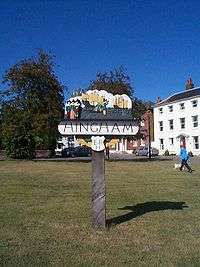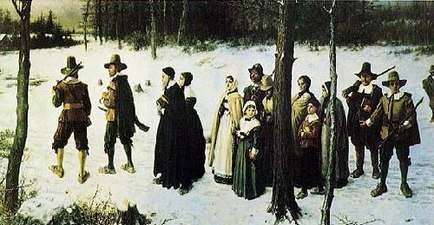Puritan migration to New England (1620–40)
The Puritan migration to New England was marked in its effects in the two decades from 1620 to 1640, after which it declined sharply for a time. The term Great Migration usually refers to the migration in this period of English Puritans to Massachusetts and the West Indies, especially Barbados. They came in family groups rather than as isolated individuals and were motivated chiefly by a quest for freedom to practice their Puritan religion.[1]

Context
King James I of England made some efforts to reconcile the Puritan clergy in England, who had been alienated by the conservatism blocking reform in the Church of England. Puritans embraced Calvinism (Reformed theology) with its opposition to ritual and an emphasis on preaching, a growing sabbatarianism, and preference for a presbyterian system of church polity as opposed to the episcopal polity of the Church of England, which had also preserved medieval canon law almost intact. They opposed church practices that resembled Roman Catholic ritual.
This religious conflict worsened after Charles I became king in 1625, and Parliament increasingly opposed his authority. In 1629, Charles dissolved Parliament with no intention of summoning a new one, in an ill-fated attempt to neutralize his enemies there—which included numerous Puritans. With the religious and political climate so unpromising, many Puritans decided to leave the country. Some of the migration was also from the expatriate English communities in the Netherlands of nonconformists and Separatists who had set up churches there since the 1590s.
The Winthrop Fleet of 1630 included eleven ships led by the flagship Arbella; it delivered some 700[2] passengers to the Massachusetts Bay Colony. Migration continued until Parliament was reconvened in 1640, at which point the scale dropped off sharply. The English Civil War began in 1641, and some colonists returned from New England to England to fight on the Puritan side. Many then remained in England, since Oliver Cromwell backed Parliament as an Independent.[3]
The Great Migration saw 80,000 people leave England, roughly 20,000 migrating to each of four destinations: Ireland, New England,[4] the West Indies, and the Netherlands. The immigrants to New England came from every English county except Westmorland, and nearly half from East Anglia.[5] The colonists to New England were mostly families with some education who were leading relatively prosperous lives in England.[1] One modern writer, however, estimates that 7 to 10 percent of the colonists returned to England after 1640, including about a third of the clergymen.[6]
Religious societies in New England
The Puritans created a deeply religious, socially tight-knit, and politically innovative culture that is still present within the modern United States. They hoped that this new land would serve as a "redeemer nation." They fled England and attempted to create a "nation of saints" in America: an intensely religious, thoroughly righteous community designed to be an example for all of Europe.
Roger Williams preached religious toleration, separation of church and state, and a complete break with the Church of England. He was banished from the Massachusetts Bay Colony and founded Providence Plantations, which became the Rhode Island Colony and provided a haven for others such as Anne Hutchinson.[7] Quakers were also expelled from Massachusetts, but they were welcomed in Rhode Island.[8] Years later, four Quakers known as the Boston martyrs remained in Massachusetts and were hanged for practicing their religion.
References
- 1 2 Betlock, Lynn. "New England's Great Migration". Retrieved 28 April 2008.
- ↑ John Winthrop, The History of New England from 1630 to 1649, Vol. I, 2nd edition (James Savage, ed.), Little, Brown and Company publ. 1853, page 442
- ↑ Hopley, Claire. "The Puritan Migration: Albion's Seed Sets Sail". Archived from the original on 12 February 2008. Retrieved 5 December 2008.
- ↑ Roscoe Lewis Ashley (1908). American History. New York: Macmillan. p. 52. Retrieved 7 October 2013.
- ↑ Barnette, Mic. "East Anglian Puritans 1629-1640". Puritans to New England.
- ↑ Susan Hardman Moore, Pilgrims: New World Settlers and the Call of Home (2007).
- ↑ Edwin S. Gaustad, Roger Williams (2005).
- ↑ Carla Gardina Pestana, Quakers and Baptists in Colonial Massachusetts (1991).
Further reading
- Adams, James Truslow (1921). The Founding of New England. New York: Atlantic Monthly Press.
- Robert Charles Anderson (1999). The Great Migration Begins: Immigrants to New England, 1620–1633. Boston: New England Historic Genealogical Society. Three volumes.
- Anderson, Virginia DeJohn. "Migrants and Motives: Religion and the Settlement of New England, 1630–1640," New England Quarterly, Vol. 58, No. 3 (Sep., 1985), pp. 339–383 in JSTOR
- Anderson, Virginia DeJohn. New England's Generation: The Great Migration and the Formation of Society and Culture in the Seventeenth Century (1991) excerpt and text search
- Bailyn, Bernard. The Peopling of British North America: An Introduction (1988) excerpt and text search
- Breen Timothy H., and Stephen Foster. "Moving to the New World: The Character of Early Massachusetts Migration," William & Mary Quarterly 30 (1973): 189–222 in JSTOR
- Cressy, David. Coming Over: Migration and Communication between England and New England in the Seventeenth Century (1987),
- Dunn, Richard S. Puritans and Yankees: The Winthrop Dynasty of New England, 1630–1717 (1962).
- Fischer, David Hackett. Albion's Seed: Four British Folkways in America (1989), comprehensive look at major ethnic groups excerpt and text search
- Rutman, Darrett B. Winthrop's Boston (1965).
- Thompson, Roger. Mobility and Migration: East Anglian Founders of New England, 1629–1640, (1994) online edition
See also
- History of Massachusetts
- English Civil War, for further details on King Charles I's conflicts with parliament.
- Great Migration Study Project
